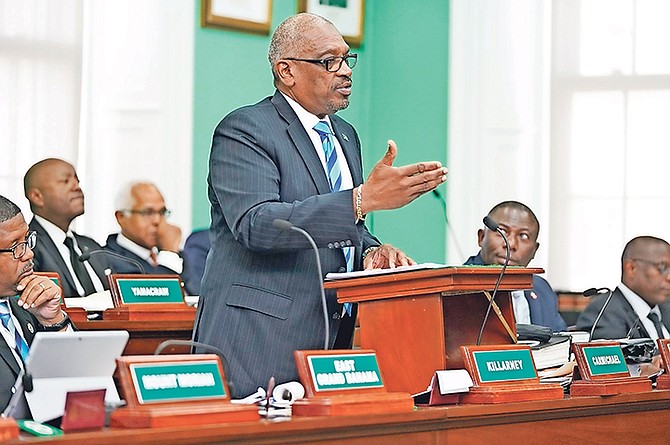Prime Minister Dr Hubert Minnis speaks in the House of Assembly on Wednesday. Photo: Terrel W. Carey Sr/Tribune Staff
By KHRISNA RUSSELL
Deputy Chief Reporter
krussell@tribunemedia.net
THE government will spend the lion’s share of its $100m Inter-American Development Bank loan on electricity restoration and enhanced social welfare measures, according to Prime Minister Dr Hubert Minnis yesterday.
Speaking in the House of Assembly, Dr Minnis explained how these funds in addition to $5.1m donated to the National Emergency Management Agency are to be spent along with other money available to the government for Hurricane Dorian related activities.
He revealed that there is $40m in dormant accounts, adding the Central Bank of the Bahamas had advised that the government use no more than half of the money.
Dr Minnis said it was most fortunate that his administration put the IDB loan facility in place back in April.
“Unlike past hurricanes, The Bahamas is able to quickly draw on this $100m facility because of the foresight of this administration,” he told Parliament.
In some circles people have questioned why the government needed this loan, while others have continued to criticise its response after the storm.
To this, the Killarney MP said teams were mobilised immediately and went into affected areas as soon as was possible.
The IDB will work along with the Ministry of Finance to conduct a comprehensive assessment that will determine the overall social and economic impact of Dorian.
“There is much work ahead, but we will rebuild, we will be made stronger, and we will be made whole again, through the grace and guidance of Almighty God,” Dr Minnis also said.
But the situation has presented challenges to the government’s ambitions for the economy to perform at or above economic growth of 2017 and 2018. In 2017, growth was 1.4 percent and 1.6 percent the following year.
The government is proposing to use $30m of the loan for electricity restoration; $30m on welfare and $15m for water restoration.
Debris removal and clean-up will require $15m and reimbursement of evacuation and shelter cost will cost $1m.
Nine million dollars is unallocated, Dr Minnis said. However, he said the estimates are subject to further refinement.
Regarding the money contained in dormant accounts, the government plans to use $20m, of which $10m will support small businesses in economic recovery zones.
An additional $5m is to pay for temporary housing accommodations in affected areas, while another $5m it allocated for other Hurricane Dorian recovery efforts that have not been determined. This $5m, Dr Minnis said will only be utilised upon consent of the minister of disaster preparedness, recovery and reconstruction.
“Once again, it is fortuitous that this administration had the foresight and forward-thinking in deploying these funds for disaster recovery and reconstruction. The dormant account funds are under the care of the Central Bank, which has recommended that the government use no more than half these funds.
“The Ministry of Finance will determine and coordinate the disbursement schedule with the Central Bank,” Dr Minnis said.
From its three tropical cyclone policies and three excess rainfall policies with the Caribbean Catastrophe Risk Insurance Facility the government received $12.8m.
Each covers a section or zone of the archipelago: north west, south east and central.
“It is most fortunate that we restored this facility after it was previously cancelled, a matter which should be debated on another occasion.”
Hurricane Dorian restoration efforts were supported by a number of monetary donations made to NEMA.
As of the end of September 30, the organisation received donations totaling $5,159,007.52. This does not include pledges.
Dr Minnis said corporate donors gave $1,362,025.02 and those in the private sector donated $1,325,388.97.
Foreign governments gave $1,901,250 and non-governmental organisations gave $345,343.53 while intergovernmental donations amounted to $225,000.
The United Nations Development Programme is also expected to contribute one million dollars for Hurricane Dorian recovery efforts. This UNDP funding will guarantee technical assistance in early recovery interventions for crucial areas.
Dr Minnis explained: “It will also help promote environmentally sustainable resilient infrastructure; develop national and local capacities for disaster-risk reduction and recovery; and support livelihoods and economic recovery of most vulnerable communities.”





Comments
Well_mudda_take_sic 4 years, 6 months ago
Our Triple D Size Duckin' & Dodgin' Doc talks about borrowing for this and borrowing for that, and money for this and money for that. But notice how he says absolutely nothing, nada, about funds being borrowed or otherwise obtained for the purpose of expeditiously rounding up, detaining and then quickly deporting the many thousands of illegal Haitian aliens back to Haiti.
As for the $30 million Minnis says will be borrowed for welfare costs, we can safely bet most of that and then plenty more on top of that will be devoured by our illegal Haitian community.
Sign in to comment
Or login with:
OpenID